At Lifeology, we’re all about improving the communication and teaching of science through interactive and innovative ways (such as our illustrated short flashcard courses on various scientific topics). Keep reading to hear from one of Lifeology’s community members about another innovative way to communicate about science— through quilting!
There are several opportunities to celebrate science in creative ways, from Science’s annual Dance Your Ph.D. contest to the AGU/EGU workshops to help one Rhyme Your Research. Groups like the Tempestry Project encourage climate activism with crochet hooks and knitting needles to generate data visualizations of temperature changes made from yarn. And a new crafting project is taking place this year to bring quilters together of all ages and skill levels to create mini quilts on any earth or space science topic – welcome to Quilt Your Science 2021!
Starting now and through November 15, 2021, individuals or groups are encouraged to create a mini quilt (between 12 inches and 24 inches on each side) that captures your own work or your passion for earth and space science research, communication, and/or education. The fabric choices and design are entirely up to the quilter, as well as the science story they want to tell with their quilt. In December 2021, there will be a virtual reality exhibition of the mini quilts (see an example of how the display will be set up in Artsteps).
Myself and the project co-lead, Betsy Wilkening (Arizona Project WET), are also planning to have a live celebration to allow in-person and virtual participants celebrate the display (pending health restrictions, the celebration will take place at the 2021 AGU Fall Meeting in New Orleans, Louisiana and online). Please visit the Quilt Your Science 2021 website to learn more, to be inspired, and to start quilting!

Quilt in a Sudoku pattern representing solutions to climate change from Project Drawdown. A full quilt description with video is available here.
So where did Betsy and I come up with the idea to organize a global celebration of science through quilts? We first met during a virtual Braindate at the 2020 AGU Fall Meeting. I have been a quilter for a number of years, but I haven’t seen many people create a quilt with a science storyline. And with quilting being such a solitary craft, especially during this pandemic year, I thought it would be interesting to see if I could bring a group together to create quilts along a common theme and then celebrate our creativity as a community with a showcase of the collection.
My personal journey into quilting started back in 2006, when I inherited my grandmother’s sewing machine upon her passing. My grandmother and I shared a passion for crocheting and would share our projects with each other. But sewing? That’s something I hadn’t done since middle school. So I signed up for classes at a local craft store for a refresher, and before I knew it, I had completed my first quilt!
I continued quilting items for friends as gifts, but then my shift to using quilts to tell stories of science came in 2018. The Louisiana Universities Marine Consortium (LUMCON) held an event called OCEANDOTCOMM, where 37 scientists and science communicators came together to find ways to tell stories of coastal optimism – not the “doom and gloom” that one typically reads, but stories of adaptation and resilience along the Louisiana coast. It was this event that pushed me to explore a new and different way for me to share stories about the people I met and places I explored during OCEANDOTCOMM. The final product was not one quilt but a collection of quilts titled Stitching Hope for the Louisiana Coast.
I’m certainly not the first person to tell a story with a quilt. For centuries, quilts have been sewn to hold memories, moments, and lives. From utilizing worn-out clothes to communicating messages, story quilts have been created for personal reasons and have even been the foundation of lesson plans for elementary school students.
The advantage of using a quilt as a science communication tool is that when people see a quilt, there is an instantaneous connection. Everyone has a quilt story, from a handmade blanket their grandmother created to a quilt that has been in the family for generations. I have found that quilts open doors to new audiences for me to share stories of science – and then, so many people are further sharing photos and the stories they just learned.
But can people really learn about science from a quilt? It depends upon the story and how much one is trying to share. Just like paintings hanging on the wall of a museum, there is a description with the title and information on what the artist is conveying in their work. A quilted science story is the same – supplemental information can and should be provided for the full context and explanation, so there are no misinterpretations or misunderstandings of the science (see the second quilt in the virtual exhibition linked above). I have found it challenging to create quilts that tell a story relating to climate impacts that end with hope – but it can be done!
We hope you will consider adding your science story to Quilt Your Science 2021.





